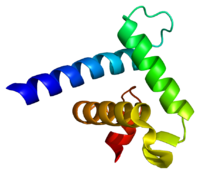
Photo from wikipedia
Background Nuclear factor-κB (NF-κB) plays a prominent role in promoting inflammation and resistance to DNA damaging therapy. We searched for proteins that modulate the NF-κB response as a prerequisite to… Click to show full abstract
Background Nuclear factor-κB (NF-κB) plays a prominent role in promoting inflammation and resistance to DNA damaging therapy. We searched for proteins that modulate the NF-κB response as a prerequisite to identifying novel factors that affect sensitivity to DNA damaging chemotherapy. Results Using streptavidin-agarose pull-down, we identified the DExD/H-box RNA helicase, DDX39B, as a factor that differentially interacts with κB DNA probes. Subsequently, using both RNA interference and CRISPR/Cas9 technology, we demonstrated that DDX39B inhibits NF-κB activity by a general mechanism involving inhibition of p65 phosphorylation. Mechanistically, DDX39B mediates this effect by interacting with the pattern recognition receptor (PRR), LGP2, a pathway that required the cellular response to cytoplasmic double-stranded RNA (dsRNA). From a functional standpoint, loss of DDX39B promoted resistance to alkylating chemotherapy in glioblastoma cells. Further examination of DDX39B demonstrated that its protein abundance was regulated by site-specific sumoylation that promoted its poly-ubiquitination and degradation. These post-translational modifications required the presence of the SUMO E3 ligase, PIASx-β. Finally, genome-wide analysis demonstrated that despite the link to the PRR system, DDX39B did not generally inhibit interferon-stimulated gene expression, but rather acted to attenuate expression of factors associated with the extracellular matrix, cellular migration, and angiogenesis. Conclusions These results identify DDX39B, a factor with known functions in mRNA splicing and nuclear export, as an RNA-binding protein that blocks a subset of the inflammatory response. While these findings identify a pathway by which DDX39B promotes sensitization to DNA damaging therapy, the data also reveal a mechanism by which this helicase may act to mitigate autoimmune disease.
Journal Title: BMC Biology
Year Published: 2020
Link to full text (if available)
Share on Social Media: Sign Up to like & get
recommendations!